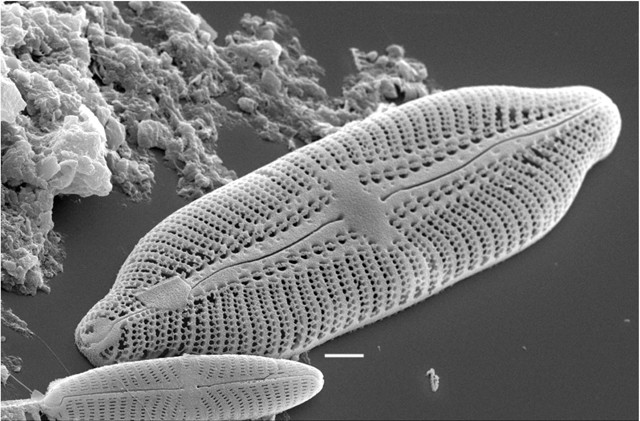
by U.S. Geological Survey Wednesday, June 13, 2018
Robert D. Crangle Jr., a mineral commodity specialist for the U.S. Geological Survey, compiled the following information on diatomite, an essential commodity for the filtration and construction industries.

Microscopic diatom shells are used to filter microbes and disease-causing viruses from public water systems. Diatomite is also used to filter sugar, oil, organic and inorganic chemicals, and various alcoholic beverages, including beer and wine. Credit: Sarah Spaulding/USGS
Diatomite is a soft, friable and very fine-grained siliceous sedimentary rock composed of the remains of fossilized diatoms. Chalky to the touch and often light in color, diatomite can be white if pure, but more commonly it is buff to gray in situ, or sometimes black. Because of its low density and high porosity, it is extremely lightweight, and it is essentially chemically inert. Its properties make diatomite very useful as a filtration medium as well as a component in cement.
Diatomaceous earth (often abbreviated as D.E.) is a common alternate name, although D.E. more appropriately describes the unconsolidated or less lithified sediment of the same composition. Diatomite is also known as kieselguhr (Germany), tripolite (after an occurrence near Tripoli, Libya), and moler (a unique clayey form of diatomite found in Denmark). Part of the mineral’s name made it into the public lexicon when Alfred Nobel named his explosive invention “dynamite” after discovering that nitroglycerin could be stabilized if it is first absorbed in diatomite.
Diatomite deposits formed when the skeletons of dead diatoms accumulated in either marine or freshwater environments and were subsequently compressed and lithified. The microscopic, single-celled aquatic plants (algae) produce biogenic silica internally, which they excrete to produce elaborate exoskeletons consisting of two frustules (valves) that can vary in size, depending on the species, from less than 1 micrometer to more than 1 millimeter in diameter, but typically they are 10 to 200 micrometers in diameter. The frustules display a broad variety of delicate, lacy and perforated shapes, including cylinders, discs, feathers, ladders, needles and spheres. The oldest occurrences of diatomite are thought to be of Cretaceous age, deposited between about 138 million and 66 million years ago. Older diatomite occurrences may have been altered into other forms of silica, particularly chert, owing to burial, diagenesis and exposure.
For more information on diatomite and other mineral resources, visit: minerals.usgs.gov/minerals.
Diatomite production and consumption
The United States is the world’s leading producer and exporter of diatomite, with more than 800,000 metric tons mined, and more than 100,000 metric tons exported in 2011.
The largest known diatomite deposit in the world is located in Lompoc, Calif.
In the United States, diatomite is produced by seven companies at 10 separate mining areas in California, Nevada, Oregon and Washington.
The filtration markets in the United States consumed approximately 67 percent of all domestically mined diatomite in 2011.
Fun Facts
More than 200 different kinds of diatoms are known to exist today, with an estimated 100,000 extinct species; they comprise one of the primary forms of oceanic plankton.
Some diatomite is mined for its use in filtering human blood plasma.
Diatomite can be used as a nontoxic insecticide to desiccate pests, including bed bugs.
Diatomite is used in the production of matches: It provides friction as a match-head is ignited, while also slowing the speed of ignition to permit the matchstick to combust.
Because of its excellent ability to soak up liquids, diatomite is a main ingredient in many absorbents, including cat litter.
The value of diatomite can vary from less than $10 per metric ton as a cement additive to more than $1,000 per metric ton as a biomedical filtration medium.
© 2008-2021. All rights reserved. Any copying, redistribution or retransmission of any of the contents of this service without the expressed written permission of the American Geosciences Institute is expressly prohibited. Click here for all copyright requests.